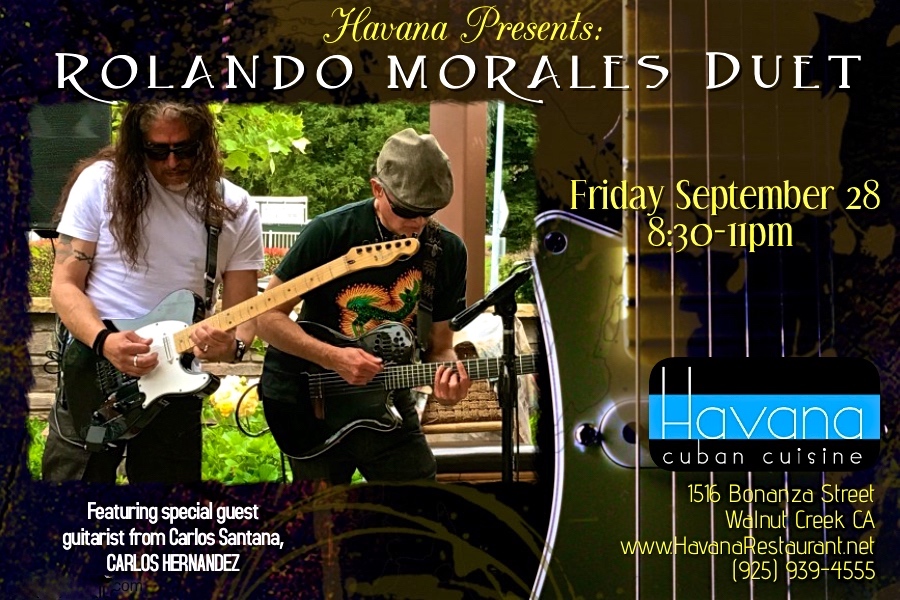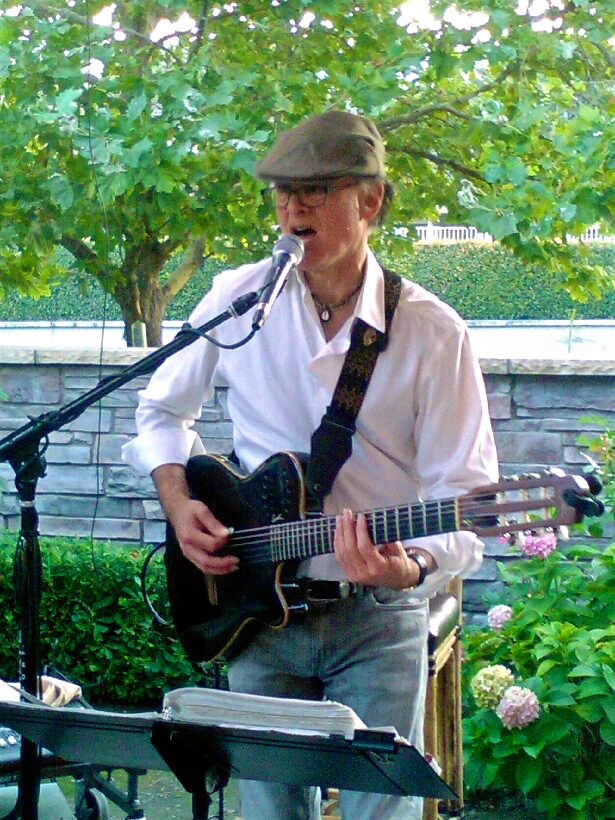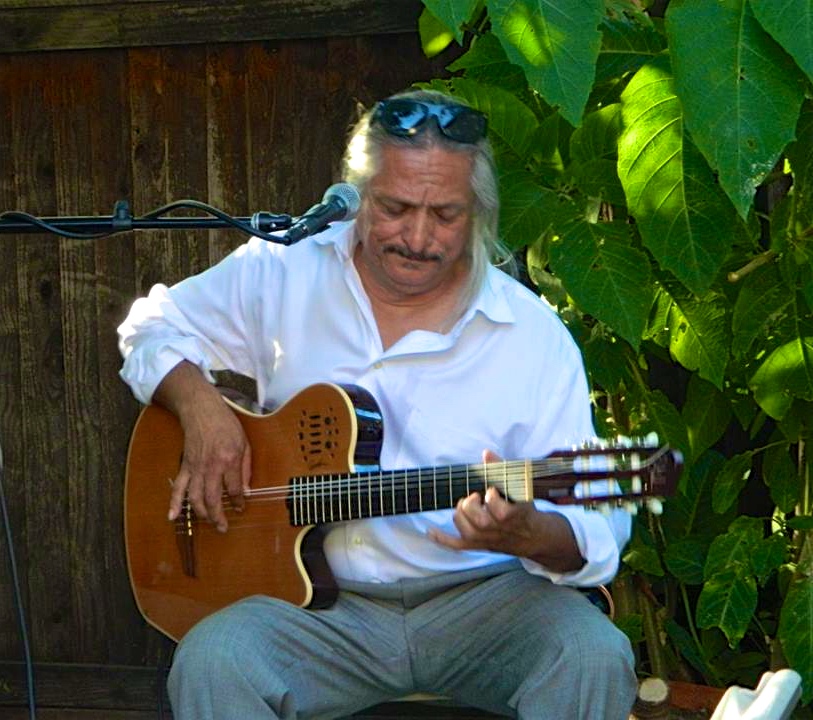September 3, 2018
¡Happy Labor Day, Mi Gente!
I hope you’re enjoying a paid day off courtesy of the American labor movement and the laws spawned from it.
Speaking of labor, my shoulders, arm and back have been screaming for a day off, so I’m giving them one. Until tomorrow.
I drop in to Maria, Maria in Walnut Creek on Tuesday September 4 out on the patio from 6-9pm for a little fun. Also to the other Maria, Maria in Danville on Friday September 7, 6-9pm out on their patio, first time in months. Details below. Those will be the only public shows of the week. All the rest are fun private events.
But I will return from those private events in time for a special public appearance at Havana in Walnut Creek, with the great Janice Maxie-Reid on keys and vocals on Saturday Sept 15. I’m really looking forward to playing in duet with her again! Details below.
And the other great duets lined up include the amazing Carlos Reyes on Saturday Sept 22; and Santana rock guitarist Carlos Hernandez on Friday Sept 28, all at Havana in Walnut Creek. These are all exciting and unique combinations with different repertoires, so if you come to each of them, you will be thoroughly entertained each time and amazed at the different talents each musician brings to the table! (And maybe by the versatility I possess to shift with the styles each musician brings to the show!) Details below.
Here’s the rest of your Calendar. See you at the show!
Ciao,
Rolando
PUBLIC PERFORMANCES FOR SEPTEMBER 2018

Rolando’s at Maria, Maria in Walnut Creek Tuesday night on the patio; Friday in Danville on their patio
Tuesday Sept 4, Maria, Maria Cantina, 1470 North Broadway, Walnut Creek, approx 6-9pm. Rolando finally returns to Carlos Santana’s Walnut Creek restaurant for Taco Tuesday. $1 tacos, baby! Enjoy Rolando on solo guitar and voice with his huge repertoire and big sound out on the front patio. He may be joined by a special musical guest. www.mariamariarestaurants.com, (925) 946-1010.
Friday Sept 7, Maria, Maria Cantina, 710 Camino Ramon Road, Danville CA, approx 6-9pm. After 3 months away, Rolando finally returns to Carlos Santana’s Danville restaurant. Enjoy Rolando on solo guitar and voice with his diverse repertoire performing on the patio by the fire pits. www.mariamariarestaurants.com, (925) 820-2366,

Saturday Sept 15, Havana Cuban Cuisine, 1516 Bonanza St., Walnut Creek, approx 8:30-11pm. Rolando returns for a special series of duet engagements at this fine Cuban restaurant and live music venue. Tonight Rolando welcomes the charming keyboardist-vocalist Janice Maxie-Reid, who has shared the stage with Stevie Wonder and Sting; and on guitar, voice and his pedal board of magic, Rolando Morales. This is a rare opportunity to catch this inspiring duet… Don’t miss it! www.havanarestaurant.net, (925) 939-4555.
Tuesday Sept 18, Maria, Maria Cantina, 1470 North Broadway, Walnut Creek, approx 6-9pm. Rolando returns to Carlos Santana’s Walnut Creek restaurant for Taco Tuesday. $1 tacos, baby! Enjoy Rolando on solo guitar and voice with his huge repertoire and big sound out on the front patio. He may be joined by a special musical guest. www.mariamariarestaurants.com, (925) 946-1010.
Friday Sept 21, Maria, Maria Cantina, 710 Camino Ramon Road, Danville CA, approx 6-9pm. Rolando finally returns to Carlos Santana’s Danville restaurant. Enjoy Rolando on solo guitar and voice with his diverse repertoire performing on the patio by the fire pits. He may have a musical guest sitting in. www.mariamariarestaurants.com, (925) 820-2366.
Saturday September 22, Havana Cuban Cuisine, 1516 Bonanza St., Walnut Creek, approx 8:30-11pm. Rolando returns to this fine Cuban restaurant and live music venue. Tonight will feature the incomparable Paraguayan violinist-bassist who has played with Arturo Sandoval and Steve Miller, the great Carlos Reyes; and on guitar, vocals and his pedal board of magic, Rolando Morales. Together they’ll light up Havana like only they can. They only do this a couple times a year, so don’t miss it! (925) 939-4555, www.havanarestaurant.net.
Tuesday September 25, Maria, Maria Cantina, 710 Camino Ramon Road, Danville CA, approx 6-9pm. Rolando finally does a Taco Tuesday at Carlos Santana’s Danville restaurant. Enjoy Rolando on solo guitar and voice with his diverse repertoire performing on the patio by the fire pits. (925) 820-2366, www.mariamariarestaurants.com.
Friday September 28, Havana Cuban Cuisine, 1516 Bonanza St., Walnut Creek, approx 8:30-11pm. Rolando returns to this fine Cuban restaurant and live music venue. Tonight will feature the rock guitarist from Carlos Santana, the exciting Carlos Hernandez; and on guitar, vocals and his pedal board of magic, Rolando Morales. Together they’ll rock Havana all night long. Don’t miss it! www.havanarestaurant.net, (925) 939-4555.

Saturday September 29, Pairings Wine Bar and Restaurant, 310 Main Street, Pleasanton CA 94566, 7:45-10:45pm. After 2 months away, Rolando finally returns to this exciting social hotspot in downtown Pleasanton. This young, expanding wine bar features fine wines, tapas and now dinners. Rolando will perform his broad repertoire on solo guitar and voice. Free! www.pairingscellars.com, (925) 398-8846.
CD SALES
If you would like to order a CD, read on. If you’d like to order our CD “Rolando Y Qué?!”, you can pick it up at my website, the gigs or by mail. They’re $15.00 at the gigs, or $17.00 by mail to cover postage and handling. TO ORDER THE NEWEST CD “ROLANDO, Y QUÉ?!” by mail: Send a check or money order payable to Rolando Morales for $17.00 for the CD and postage to Rolando Morales, 9028 Burr Street, Oakland, CA 94605. and I’ll send it to you. Let me know if you’d like .it signed.
TO ORDER THE ORIGINAL “PASSPORT: 10th ANNIVERSARY EDITION” CD by mail, send $17.00 to the same address as above. Be sure to include your return address.
BOTH CDs ARE AVAILABLE FOR PURCHASE AT WWW.ROLANDOMORALES.COM
All other shows are private. Why not hire Rolando for your own private event? He’s available for corporate shows, weddings, parties, concerts and festivals. The Rolando Morales group is available as sextet, quintet, quartet, trio and duo depending on your entertainment needs and budget.












